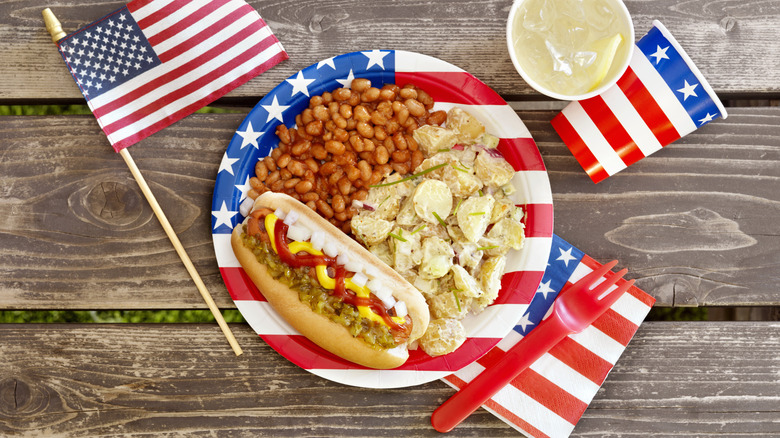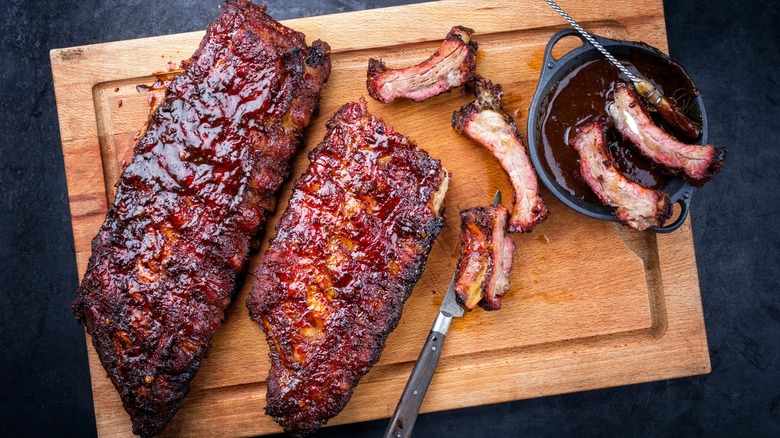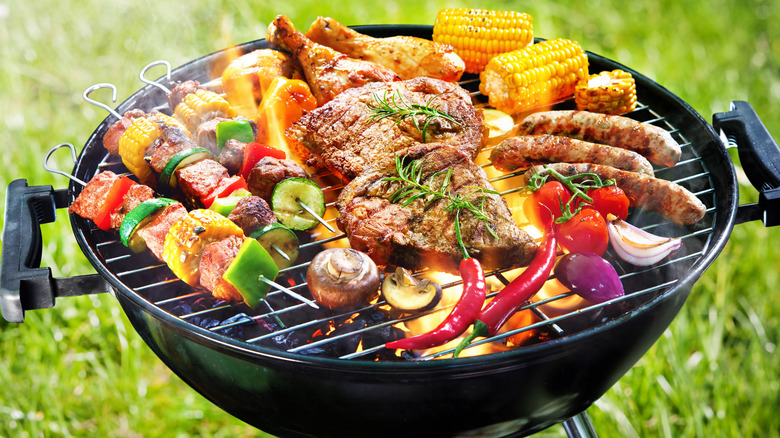Barbecues Have Been A Pivotal July 4 Tradition Since The Very Beginning
You can't have an Independence Day celebration in the U.S. without the three F's: fireworks, flags, and food. More often than not, the food in question is going to be barbecue, as July 4 is far and away the most popular day for outdoor cooking nationwide. According to data from Statista, nearly 70% of Americans report breaking out the grill to celebrate their country's independence, and if you count yourself among them, you should know you're taking part in a proud tradition that dates back further than the holiday itself.
The Fourth of July was not officially declared a national holiday until 1870, but celebrations of this occasion have been around since the beginning. John Adams wrote to his daughter in 1777, describing the festivities in Philadelphia to honor the nation's first birthday. And once the War of 1812 passed, celebrations really took off nationwide.
But before that even, beginning in the early 1800s, there were reports of barbecue cookouts being held to honor the occasion. In 1808, the local newspaper of Pendleton, South Carolina — Miller's Weekly Messenger — reported on an Independence Day parade that was immediately followed by a communal barbecue. This was an early instance that helped to cement the tradition, as only about a decade later, barbecues would be synonymous with the holiday throughout the American South.
Early July 4 barbecues were elaborate affairs
The Independence Day barbecue had become a fairly uniform tradition throughout the southern states by the 1820s. The celebrations typically began with a parade led by members of a militia. Citizens comprised the bulk of the crowd, and all would march to either the local courthouse or church, where an elaborate ceremony would commence.
A prayer was said, then someone would read the Declaration of Independence aloud, and that was followed by a sing-a-long of patriotic tunes. As time wore on, politicians began seizing these events as opportunities to advance their various interests. It became customary for government figures from the local level to make speeches, after which the assembled masses would make their way to an outdoor seating area for a grand barbecue feast.
The meal would be free to the public, and the cost would either be covered by local farmers' donations or by prominent members of the community. Menus varied based on regional barbecue styles and available meats. Pork, beef, chicken, goat, or even whole spit-roasted oxen might be served for the occasion.
Once the meal was done, the toasts would commence, beginning with 13 toasts (to commemorate the original colonies) done by notable locals. After that, the floor would be opened to voluntary toasts, which went on for as long as folks had something to say. These highly formalized events spread westward with Americans to places like Texas and Kansas City, which soon developed their own July 4 barbecue traditions.
Historic barbecues highlighted America's racial divide
Early celebrations of the Fourth of July weren't all innocent fun, as they also underscored the nation's racist history. Such holiday celebrations were often segregated affairs. White attendees ate first, and enslaved people were forced to handle the cooking as well as set up the event space and serve white diners.
In the aftermath of the Civil War, many white Southerners stung by defeat quit celebrating the Fourth of July altogether. Yet, many Black Americans kept up the tradition of celebrating with a communal barbecue. This went on for decades, and it wasn't until the 1920s that many white people in the American South got truly back aboard the Independence Day train.
The 20th century changed the nature of July 4 barbecues in multiple ways. The tradition of community cookouts where one could eat for free vanished, as the need to fund the work involved plus rising meat prices led to smaller events that charged guests to eat. Public gatherings also gave way to family events in more contained settings because the American population transitioned from being primarily rural to mostly urban and suburban.
Lastly, barbecue technology dramatically changed in this time, with the traditional roasting methods becoming less common as compact kettle grills took over. All these factors combined led the traditional July 4 cookout to morph from a giant free-for-all into a more reduced yet intimate affair. And as long as the charcoal keeps burning, it will likely remain that way.


